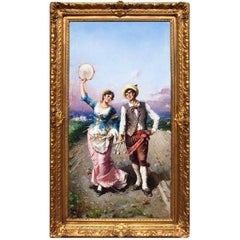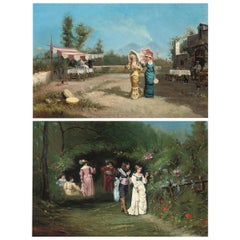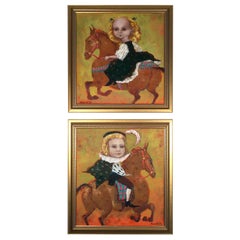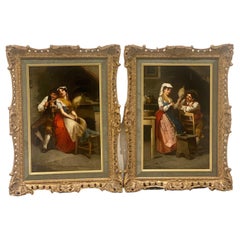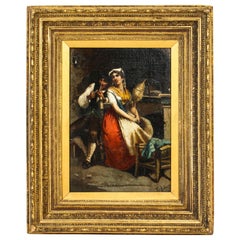Francesco Peluso Wall Decorations
to
1
1
1
2
Height
to
Width
to
2
2
2
2
1
1
2
2
2
2
2
2
436
301
286
282
Creator: Francesco Peluso
Francesco Peluso (Italian, 1836-1916) An Oil on Canvas "The Village Celebration"
By Francesco Peluso
Located in Los Angeles, CA
Francesco Peluso (Italian, 1836-1916) a fine Italian 19th-20th century oil on canvas "The Village Celebration" depicting a young couple of villagers dressed for Spring festivities and walking through a dirt road while playing musical instruments. The girl playing a tambourine and the boy a wooden noise maker...
Category
Late 19th Century Italian Country Antique Francesco Peluso Wall Decorations
Materials
Gesso, Canvas, Wood
$7,950 Sale Price
38% Off
Pair of Paintings by Francesco Peluso
By Francesco Peluso
Located in Brighton, West Sussex
A pair of paintings by Francesco Peluso (1836-1916): 'Neapolitan Promenade’ and ‘Pastoral Promenade’.
Oil on canvas.
Signed 'F Peluso' to the ...
Category
19th Century Italian Antique Francesco Peluso Wall Decorations
Materials
Canvas, Giltwood
$7,537 / set
Related Items
Italian Orientalist Oil on Canvas Painting
Located in Cypress, CA
Italian orientalist oil on canvas painting.
20th century.
The fine oil painting depicting an orientalist woman dressed in traditional garments w...
Category
20th Century Italian Francesco Peluso Wall Decorations
Materials
Canvas, Wood
Pair of Russian Whimsical Paintings by Elena Kallistova
Located in Lambertville, NJ
Whimsical oil paintings by Noted Russian artist Elena Kallistrova. Each depiction a young boy and girl riding on a horse in fanciful costume. Signed and dated on lower corner, 1999
...
Category
20th Century Russian Modern Francesco Peluso Wall Decorations
Materials
Paint
Harvesting The Wheat, Oil on Canvas, Italian, 1950s
Located in St Annes, Lancashire
Wonderful painting of farmers bringing in the harvest of wheat
Oil on canvas. Unsigned. Artist unknown
Framed in a slightly distressed antiqu...
Category
1950s Italian Mid-Century Modern Vintage Francesco Peluso Wall Decorations
Materials
Other
Oil on Canvas Italian Street Market Scene by Giuseppe Pitto
By Giuseppe Pitto
Located in Chicago, IL
Giuseppe Pitto (Italian 1857 - 1928) is often known for his paintings depicting pretty women in Italian street markets. This exuberantly painted scene i...
Category
Late 19th Century Italian Other Antique Francesco Peluso Wall Decorations
Materials
Gesso, Canvas, Giltwood, Paint
Pair of Vintage Indonesian/Balinese Paintings by Artist W. Suaridi
Located in COLMAR, FR
Two absolutely fantastic, vintage paintings from Indonesia in a traditional Balinese style. One of the paintings is signed by the artist, W. Suaridi in the lower left (see photo). Bo...
Category
Late 20th Century Indonesian Folk Art Francesco Peluso Wall Decorations
Materials
Plywood
$1,917 Sale Price
35% Off
H 15.75 in W 11.03 in D 0.6 in
John Lochhead "the Trysting Place" Oil on Canvas in Period Frame
Located in San Francisco, CA
A pretty oil on canvas by John Lochhead (1868-1921) a listed British artist born in 1868. The style of the painting is classic Victorian with a slightly naughty title on the back label "The Trysting Place". The piece depicts a well-dressed young woman seated on a bench in a charming bucolic garden setting with grazing sheep on a riverbank. The frame is a fine example of elaborate late 19th century carved giltwood with the label of a well-known carver and gilder...
Category
Early 20th Century English Victorian Francesco Peluso Wall Decorations
Materials
Giltwood, Paint
Pair Of Framed OIl Paintings Of Santa Barbara By DeWitt Parshall
Located in Essex, MA
Each oil on panel depicting Santa Barbara seacoast. Giltwood frames and paintings under glass. Parshall was an American painter born in Buffalo and was based in Montecito since 1916....
Category
1920s American Arts and Crafts Vintage Francesco Peluso Wall Decorations
Materials
Canvas, Glass, Giltwood
$6,850 / set
H 11.75 in W 13.25 in D 0.75 in
Large Scale Italian Oil on Canvas Painting
Located in Round Top, TX
An outstanding and grand scale oil on canvas painting of a nude male. Entitled "La Vittoria Della Verita' Sull'Insidia" - "The Victory Of Truth Over The Trap"..... Expertly executed ...
Category
Early 20th Century Italian Francesco Peluso Wall Decorations
Materials
Canvas
Antique Oil on Canvas Painting by Francesco Bergamini 19th Century
By Francesco Bergamini 1
Located in London, GB
This is a truly splendid antique oil on canvas painting featuring a period interior scene by Francesco Bergamini (1851-1900) Italian, signed and dated 1894.
This beautiful oil pai...
Category
1890s Italian Antique Francesco Peluso Wall Decorations
Materials
Canvas, Giltwood
$5,712
H 28.75 in W 40.95 in D 2.76 in
17th Century Italian Flemish Oil on Canvas Painting of Adoration of the Magi
Located in North Miami, FL
17th Century Italian Flemish oil on canvas painting depicting the Adoration of the Magi. Early Flemish painting was contemporary to the development of the early Renaissance in Italy. In the middle of the 15th century Italy...
Category
17th Century Italian Baroque Antique Francesco Peluso Wall Decorations
Materials
Wood, Giltwood, Paint
$26,663 Sale Price
24% Off
H 21.25 in W 69 in D 1 in
Pair of Vintage Dutch Paintings
Located in New York, NY
Pair of circa 1940's oil on canvas Adam and Eve paintings with vintage frames.
Measurements:
Height: 74.25"
Width: 32.75"
Depth: 2.25"
Category
1940s Dutch Vintage Francesco Peluso Wall Decorations
Materials
Canvas, Wood
Maritime Oil on Canvas
Located in Cypress, CA
Maritime oil on canvas depicting a port scene.
Within a later wooden frame.
Late 19th-early 20th century
Back of the canvas reads: "J. Harvey, 15 Cat...
Category
Early 20th Century Francesco Peluso Wall Decorations
Materials
Canvas
Previously Available Items
Francesco Peluso 'Italian, 1836-1916' a Pair of Oil on Canvas Paintings
By Francesco Peluso
Located in London, GB
Francesco Peluso (Italian, 1836-1916) a superb pair of Italian 19th-20th century oil on canvas paintings. Pair of Works: Spinning Yarn; and a Rest from Work, within a gilt wood and g...
Category
1880s Italian Antique Francesco Peluso Wall Decorations
Materials
Canvas
Antique Italian Oil Painting Francesco Peluso, 19th Century
By Francesco Peluso
Located in London, GB
This is a beautiful antique oil on canvas painting of a interior scene by Francesco Peluso born 1836, circa 1870 in date and signed lower right.
The painting features an Italian c...
Category
1870s Italian Antique Francesco Peluso Wall Decorations
Materials
Canvas
Francesco Peluso Antique Oil Painting, "Indiscretions", Signed
By Francesco Peluso
Located in Shippensburg, PA
Francesco Peluso (italian, B. 1836) Antique Oil Painting On Canvas, Interior Scene
"Indiscretions" signed lower right, retaining gallery label on verso stretcher
This is a positi...
Category
19th Century Italian Romantic Antique Francesco Peluso Wall Decorations
Materials
Canvas
Francesco Peluso wall decorations for sale on 1stDibs.
Francesco Peluso wall decorations are available for sale on 1stDibs. These distinctive items are frequently made of fabric and are designed with extraordinary care. There are many options to choose from in our collection of Francesco Peluso wall decorations, although brown editions of this piece are particularly popular. If you’re looking for additional options, many customers also consider wall decorations by and Eugenio Zampighi. Prices for Francesco Peluso wall decorations can differ depending upon size, time period and other attributes — on 1stDibs, these items begin at $2,914 and can go as high as $12,950, while a piece like these, on average, fetch $6,813.
